
If you think you know what the original purpose was for a gargoyle, test yourself. Was it: 1) A decorative architectural element; 2) A functional architectural element, or 3) An excuse for a movie?
If you chose #2, pat yourself on the back. Original stone grotesques, or gargoyles, had a functional purpose. A trough was cut in the back of the gargoyle so that rainwater could flow through its open mouth. This was important because keeping rainwater from running down masonry walls saved the mortar between stone blocks. The length of a gargoyle determined how far water was thrown from the wall, so these creatures were often elongated and fantastical. In fact, the word, “gargoyle” originated from the French word for “throat” or “gullet.” As is so often the case, people came to attribute fanciful qualities to representative images over time, and in the case of gargoyles, the stone statues were said to scare off harmful spirits and protect the people within a building from evil, particularly when the gargoyle was strictly decorative.
It’s a wonder there weren’t more “dog gargoyles,” since in life, dogs protect their people. One Catholic cathedral in the German city of Worms does includes a dog on its facade, a sculpture of a Dachshund. According to legend, the Dachshund saved the life of her owner-architect, and in gratitude, he put her image on the facade.
Image found on Pinterest and happily credited upon receipt of information
